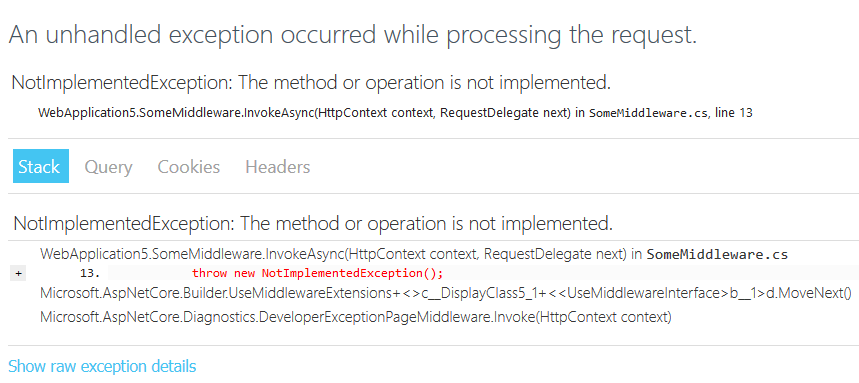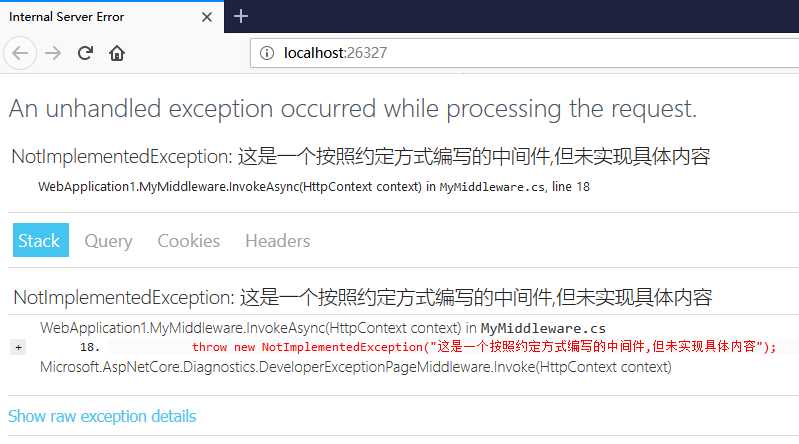ASP.NET Core 中间件的几种实现方式
2021-05-01 05:27
标签:组合 响应 linq 快速 sharp startup sha src core ASP.NET Core 中 HTTP 管道使用中间件组合处理的方式, 换句人话来说, 对于写代码的人而言,一切皆中间件. 业务逻辑/数据访问/等等一切都需要以中间件的方式来呈现. 那么我们必须学会如何实现自定义中间件 这里我们介绍下中间件的几种实现方式... 通常新建一个空的 ASP.NET Core Web Application, 在启动类里可以看到这么一句: 这就是一个匿名函数实现的中间件,虽然内容比较少. 可以看到通过匿名函数实现的中间件是内嵌在启动类文件中的,因此通常也叫做内联中间件 接下来,我们通过匿名函数来实现内联中间件,以便加深理解. 新建一个空的 ASP.NET Core Web Application 然后修改启动类代码如下: 这里我们在 我们 F5 启动下,看看页面 嗯,符合预期. 我们再来调整下启动类,代码如下: 这里我们在 我们 F5 启动,看看效果 嗯,符合预期. 通过实现接口 接口 IMiddleware 定义如下: 可以看到接口 IMiddleware 的命名空间是 嗯,重新开始,我们新建一个空的 ASP.NET Core Web Application 然后我们通过实现接口的方式来自定义一个中间件,代码如下: 按照上面实现的中间件 使用接口实现的中间件需要在先在服务容器中注册 然后 F5 启动,页面上可以看到如下结果: 符合我们上面的预期,抛出了一个 然后我们改造下 这里相当于我们实现了一个叫做 然后我们 F5 启动看看 嗯...符合预期. 编程世界有这么一句话,叫"约定大于配置". 那么编写中间件的约定是什么呢? 重新开始,新建一个空的 ASP.NET Core Web Application 然后新建一个类,类名叫做 约定的内容,就是满足2个需要...不满足需要则异常. 然后我们把这个中间件,注册到管道中,以便使用 然后 F5 启动,来看看效果 嗯,符合预期. 然后我们来调整下中间件,让请求能正常响应输出 然后 F5 启动,看看效果 嗯,符合预期. 写在最后 Tips: 有些内容可能看起来还是不太容易理解,至少当下你是很难理解的,但是套路就在哪里,好比1+1=2,你知道1+1为什么=2么?但你一定会算会用1+1=2... ASP.NET Core 中间件的几种实现方式 标签:组合 响应 linq 快速 sharp startup sha src core 原文地址:https://www.cnblogs.com/taadis/p/12148859.html前言
这里划重点,必考匿名函数
项目名字无所谓啦// Startup.cs
// ...
app.Run(async (context) =>
{
await context.Response.WriteAsync("Hello World!");
});
// ...// Startup.cs
using Microsoft.AspNetCore.Builder;
using Microsoft.AspNetCore.Hosting;
using Microsoft.AspNetCore.Http;
using Microsoft.Extensions.DependencyInjection;
using System;
namespace WebApplication1
{
public class Startup
{
public void ConfigureServices(IServiceCollection services)
{
}
public void Configure(IApplicationBuilder app, IHostingEnvironment env)
{
if (env.IsDevelopment())
{
app.UseDeveloperExceptionPage();
}
// 使用匿名函数实现一个内联中间件
app.Use(async (context, next) =>
{
throw new NotImplementedException("一个使用匿名函数,但未实现具体内容的内联中间件");
});
app.Run(async (context) =>
{
await context.Response.WriteAsync("Hello World!");
});
}
}
}
app.Run 之前使用 app.Use 添加一个匿名函数实现的内联中间件,按照中间件的注册顺序,当发起请求时,会抛出一个异常 NotImplementedException("一个使用匿名函数,但未实现具体内容的内联中间件")
using Microsoft.AspNetCore.Builder;
using Microsoft.AspNetCore.Hosting;
using Microsoft.AspNetCore.Http;
using Microsoft.Extensions.DependencyInjection;
namespace WebApplication1
{
public class Startup
{
public void ConfigureServices(IServiceCollection services)
{
}
public void Configure(IApplicationBuilder app, IHostingEnvironment env)
{
if (env.IsDevelopment())
{
app.UseDeveloperExceptionPage();
}
// 使用匿名函数实现一个内联中间件
app.Use(async (context, next) =>
{
// 这里不对 request 做任何处理,直接调用下一个中间件
await next.Invoke();
});
app.Run(async (context) =>
{
await context.Response.WriteAsync("Hello World!");
});
}
}
}
app.Run 之前使用 app.Use 添加一个匿名函数实现的内联中间件,该中间件没有对 request 做任何处理,只是一个空的空间件,按照中间件的注册顺序,当发起请求时,页面应该显示 Hello World!.
个人觉得:匿名函数不是很直观,但是用内联的方式可以快速开始一些开发,不用新建一个中间件类,不用专门想个不一样的名字,小场景下是非常方便实用的实现接口
IMiddleware 编写自定义中间件,这是一种强类型的方式,我们需要必须强制按照接口的定义来实现.IMiddleware
using System.Threading.Tasks;
namespace Microsoft.AspNetCore.Http
{
public interface IMiddleware
{
Task InvokeAsync(HttpContext context, RequestDelegate next);
}
}
Microsoft.AspNetCore.Http,需要实现的方法是InvokeAsync(),看起来不算太复杂, 嗯,看起来不算太复杂// 新建类 MyMiddleware.cs
using Microsoft.AspNetCore.Http;
using System;
using System.Collections.Generic;
using System.Linq;
using System.Threading.Tasks;
namespace WebApplication1
{
public class MyMiddleware : IMiddleware
{
public Task InvokeAsync(HttpContext context, RequestDelegate next)
{
throw new NotImplementedException();
}
}
}
MyMiddleware,在执行时应该会抛出 NotImplementedException.// Startup.cs
using Microsoft.AspNetCore.Builder;
using Microsoft.AspNetCore.Hosting;
using Microsoft.AspNetCore.Http;
using Microsoft.Extensions.DependencyInjection;
namespace WebApplication1
{
public class Startup
{
public void ConfigureServices(IServiceCollection services)
{
// 在服务容器中注册自定义中间件
services.AddSingleton
NotImplementedException.MyMiddleware 中间件// MyMiddleware.cs
using Microsoft.AspNetCore.Http;
using System.Threading.Tasks;
namespace WebApplication1
{
public class MyMiddleware : IMiddleware
{
public async Task InvokeAsync(HttpContext context, RequestDelegate next)
{
// 这里不对 request 做任何处理,直接调用下一个中间件
await next(context);
}
}
}
MyMiddleware 的中间件,但是并没有对请求进行任何处理,页面上应该正常显示 Hello World! 字符串.
个人觉得:这种方式最符合面向对象的特性,也符合面向接口的原则,少一些难以理解的魔法,反而有助于理解.约定方式
MyMiddleware 好了,代码如下:// MyMiddleware.cs
using Microsoft.AspNetCore.Http;
using System;
using System.Threading.Tasks;
namespace WebApplication1
{
public class MyMiddleware
{
// 1. 需要实现一个构造函数,参数为 RequestDelegate
public MyMiddleware(RequestDelegate next)
{
}
// 2. 需要实现一个叫做 InvokeAsync 方法
public async Task InvokeAsync(HttpContext context)
{
throw new NotImplementedException("这是一个按照约定方式编写的中间件,但未实现具体内容");
}
}
}
// Startup.cs
using Microsoft.AspNetCore.Builder;
using Microsoft.AspNetCore.Hosting;
using Microsoft.AspNetCore.Http;
using Microsoft.Extensions.DependencyInjection;
namespace WebApplication1
{
public class Startup
{
public void ConfigureServices(IServiceCollection services)
{
}
public void Configure(IApplicationBuilder app, IHostingEnvironment env)
{
if (env.IsDevelopment())
{
app.UseDeveloperExceptionPage();
}
// 注册自定义中间件
// 注册顺序=1
app.UseMiddleware
Hello World!using Microsoft.AspNetCore.Http;
using System;
using System.Threading.Tasks;
namespace WebApplication1
{
public class MyMiddleware
{
private readonly RequestDelegate _next;
// 需要实现一个构造函数,参数为 RequestDelegate
public MyMiddleware(RequestDelegate next)
{
_next = next;
}
// 需要实现一个叫做 InvokeAsync 方法
public async Task InvokeAsync(HttpContext context)
{
// 不处理任何 request, 直接调用下一个中间件
await _next.Invoke(context);
}
}
}

个人觉得:只能说一句,约定方式是目前用的最多的方式...End
文章标题:ASP.NET Core 中间件的几种实现方式
文章链接:http://soscw.com/index.php/essay/80721.html